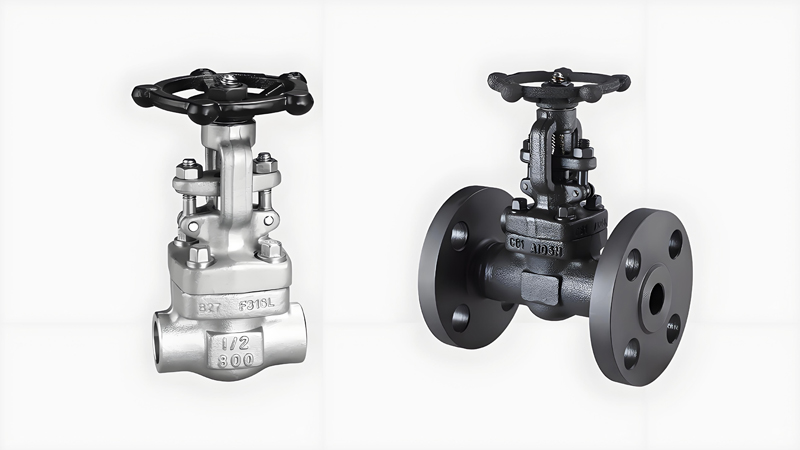The full name of API 602 standard is “API Standard 602 Gate, Globe, and Check Valves for Sizes DN 100 (NPS 4) and Smaller for the Petroleum and Natural Gas Industries“. This standard specifies the requirements for API 602 valve design, materials, dimensions, nominal pressure, structural length, manufacturing, inspection and testing in detail.
Main features and applications of API 602
1. Scope of application: Applicable to steel gate valves, globe valves and check valves with nominal size less than or equal to DN100.
2. Structure: API 602 is a compact structure, and the structural length of valves of the same specification is shorter than that of BS1873 standard.
3. Connection method: The valve can be flanged, threaded or socket welded, butt welded connected.
4. Manufacturing materials: Mainly made of carbon steel, stainless steel, bronze and other materials.
5. Sealing materials: Including metal, non-metal and composite materials.
6. Tests and inspections: Pressure test, leakage test, material test, etc. are required.

Comparison of API 602 with other standards
API 602 together with API 600, API 6D, API 599, API 594, API 609, BS 1873, BS 1868, API 598, ASME B16.5 ASME B16.34, and other standards to form a complete American standard valve design, manufacturing and acceptance system.
API 600
1. Steel Gate Valves – Flanged and Butt-Welding Ends, Bolted Bonnets
2. Design and manufacturing standards for steel gate valves for industries such as oil refining and chemical industry.
API 6D
1. Pipeline Valves
2. Design, testing and acceptance specifications for pipeline system valves (such as ball valves, gate valves, check valves, etc.).
API 599
1. Metal Plug Valves – Flanged, Threaded, and Welding Ends
2. Manufacturing, performance and testing requirements for metal plug valves (applicable to the oil and gas industry).
API 594
1. Wafer and Wafer-Lug Check Valves
2. Design and performance standards for wafer-type and wafer-lug check valves.
API 609
1. Butterfly Valves: Double Flanged, Lug- and Wafer-Type
2. Design and application specifications for double flanged, lug- and wafer-type butterfly valves (applicable to the oil and gas industry).
BS 1868
1. Specification for Steel Check Valves (Flanged and Butt-Welding Ends) for the Petroleum, Petrochemical and Allied Industries
2. British standard for steel check valves (flanges and butt-welding ends) for the petroleum, petrochemical and allied industries
BS 1873
1. Specification for Steel Globe and Globe Stop and Check Valves
2. Design and manufacturing standards for steel stop valves and stop check valves (applicable to high pressure and high temperature conditions).
ASME B16.5
1. Pipe Flanges and Flanged Fittings
2. Dimensions, pressure ratings, materials and test standards for pipe flanges and flanged fittings (covering Class 150 to 2500).
ASME B16.34
1. Valves – Flanged, Threaded, and Welding End
2. This standard specifies the pressure-temperature rating, materials, dimensions, inspection and testing requirements for flanged, threaded and welded end valves. It is applicable to steel, nickel-based alloy and other metal valves (such as gate valves, stop valves, check valves, etc.) used in industrial systems.
Notes:
- BS Standard: Some old British standards (e.g., BS 1868) may have been replaced by BS EN or ISO standards (e.g., ISO 15761). It is recommended to refer to the latest version.
- ASME standards: The version year must be marked when citing (such as ASME B16.5-2020).
- API standards: Standards such as API 6D and API 600 are frequently updated, and the latest version must be confirmed.
If you need to use it for compliance documents or procurement specifications, please refer to the official documents of the standard issuing organization (API, ASME, BSI, etc.).
API 602 valve internals configuration table
Main contents of API 602 standard document
If you need to know the specific details, you can download the latest API 602 standard from the API official website
1. Standard Overview:
- Introduce the history and background of API 602 standard.
- Explain the scope of application and purpose of the standard.
- Outline the valve types and size ranges covered by the standard.
2. Material requirements:
- Detailed introduction to the material requirements in API 602 standard.
- Includes material requirements for valve body, bonnet, seat, seat seal and other key components.
- Emphasizes requirements for material strength, corrosion resistance and wear resistance.
3. Design and manufacturing requirements:
- Explains the requirements of API 602 standard for valve design and manufacturing.
- Includes requirements such as valve size, dimensional tolerance and nominal pressure.
- Emphasizes key links in the design and manufacturing process, such as casting, forging, processing and assembly.
4. Execution and testing requirements:
- Explains the execution and testing requirements in API 602 standard in detail.
- Includes test items such as pressure test, air tightness test, leakage test and dimensional inspection.
- Emphasizes key links in the testing process, such as test pressure, test medium and test duration.
5. Standard compliance and certification:
- Introduces how to prove that the product meets the requirements of API 602 standard.
- Explains the procedures and requirements for standard compliance certification.
- Emphasizes the importance and benefits of standard compliance certification.
6. Standard Updates and Developments:
- Introduce the updates and developments of API 602 standards.
- Explain the reasons and purposes of standard updates.
- Emphasize the importance of continuous learning and following the latest developments of standards.
Post time: Mar-31-2025






